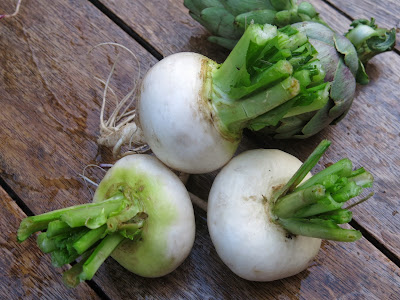It clearly pays to have the soil well-prepared. Turnips are a brassica (Brassica napus), so prefer slightly alkaline conditions in favour of acid. You can either lime the bed beforehand or if you think your soil ph is fairly neutral, use spent mushroom compost as manure. In any case, brassicas tend not to like freshly manured ground, so if you can use a bed which you manured the previous season, this should be ideal for them. In this case, the turnip bed had been used for sweetcorn, beans and squash grown in a three sisters formation, all greedy crops requiring plenty of organic matter. The seeds can be sown in March for a summer crop as I did, or continuously throughout the summer to provide roots through to late autumn and into winter.
Other tips for good turnips include not letting the growing plants dry out at any stage, or else they will become woody, and also being ruthless with thinning the crop at an early stage. I often find it difficult to pull out what look like perfectly healthy seedlings: psychologically it helps if I then eat the thinnings, in a salad, or used as green garnish. Then I feel as though I'm harvesting, rather than wasting good plants on the compost heap.
We picked and ate them when still young - about the size of a satsuma - and snowy white. They were delicately sweet with that slight mustardy tang, and were hugely popular with everyone. The most entrenched turnip sceptics were particularly won over by having the smaller ones glazed whole – cooked with butter and a little sugar as you would for glazed carrots.
Picked young, you also get the benefit of the tops, which can be cooked like spinach for a delicious fresh green.
Other tips for good turnips include not letting the growing plants dry out at any stage, or else they will become woody, and also being ruthless with thinning the crop at an early stage. I often find it difficult to pull out what look like perfectly healthy seedlings: psychologically it helps if I then eat the thinnings, in a salad, or used as green garnish. Then I feel as though I'm harvesting, rather than wasting good plants on the compost heap.
We picked and ate them when still young - about the size of a satsuma - and snowy white. They were delicately sweet with that slight mustardy tang, and were hugely popular with everyone. The most entrenched turnip sceptics were particularly won over by having the smaller ones glazed whole – cooked with butter and a little sugar as you would for glazed carrots.
Picked young, you also get the benefit of the tops, which can be cooked like spinach for a delicious fresh green.
Another similar brassica, kohl rabi (Brassica oleracea), did well too. Last year I grew the variety Delicacy Purple, sown in March the same way as for the turnips, and which cropped from July to November from a single sowing – I was pleasantly
surprised by how long the season lasted. I've always liked kohl rabi which to me taste like sweet broccoli stems - my favourite part of broccoli! The flesh of the swollen 'bulb' is a pale creamy-green colour, no matter what the colour of the skin.
In theory, kohl rabi can be prepared and eaten like turnips. In practice, mine usually end up in a salad, often with an oriental style hot, sweet dressing. I'm also happy to give them a perfunctory peeling and then munch on the kohl rabi as if it were an apple - and just as refreshing.
In theory, kohl rabi can be prepared and eaten like turnips. In practice, mine usually end up in a salad, often with an oriental style hot, sweet dressing. I'm also happy to give them a perfunctory peeling and then munch on the kohl rabi as if it were an apple - and just as refreshing.



No comments:
Post a Comment